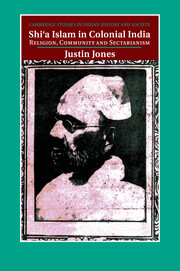Book contents
- Frontmatter
- Contents
- Figures and maps
- Preface and acknowledgements
- Frequently used abbreviations
- Note on transliteration
- Select glossary of terms
- Introduction
- 1 Madrasas, mujtahids and missionaries
- 2 Mosques, majalis and Muharram
- 3 Anjumans, endowments and Indian Shi‘ism
- 4 Aligarh, jihad and pan-Islam
- 5 The tabarra agitation and Shi‘a–Sunni conflicts in late colonial India
- Conclusion and epilogue Shi‘ism and sectarianism in modern South Asia
- Appendix Select Shi‘a ‘ulama of colonial India
- Select bibliography
- Index
- References
2 - Mosques, majalis and Muharram
Marketplace Shi‘ism
Published online by Cambridge University Press: 05 November 2011
- Frontmatter
- Contents
- Figures and maps
- Preface and acknowledgements
- Frequently used abbreviations
- Note on transliteration
- Select glossary of terms
- Introduction
- 1 Madrasas, mujtahids and missionaries
- 2 Mosques, majalis and Muharram
- 3 Anjumans, endowments and Indian Shi‘ism
- 4 Aligarh, jihad and pan-Islam
- 5 The tabarra agitation and Shi‘a–Sunni conflicts in late colonial India
- Conclusion and epilogue Shi‘ism and sectarianism in modern South Asia
- Appendix Select Shi‘a ‘ulama of colonial India
- Select bibliography
- Index
- References
Summary
Introduction
Alongside the expansion of the clerical milieu discussed earlier, a second facet of the religious renewal taking place during this period was the expansion of more informal or ‘popular’ aspects of religion: those of religious ceremony, display and public preaching. This chapter, the second to address aspects of Shi‘a religious revitalization from the late nineteenth century onwards, turns towards these public manifestations, examining the development of new religious institutions, forms of religious congregation, and the enhanced exuberance and experimentalism of public ritual. Compared to the formal ‘ulama and madrasas previously discussed, the amorphous webs of local functionaries, preachers and patrons who constituted Islam as lived in South Asia have sometimes remained poorly understood in historical contexts. Nevertheless, it was in the personages of the peshnamaz (prayer leader), wa‘iz (preacher) and zakir (sermonizer, usually indicating the ‘remembrance’ of the during ) and other functionaries that, to quote one author, ‘the passion of Shi‘ism [was] most clearly focused’.
By necessity, this focus on public forms of religion ties this chapter to studies of how, in colonial north India, religious communities were defined, reworked and expressed through visual symbols and ceremonial activities in public spaces. It has been convincingly argued that a heavily ritualized urban public sphere, a ‘world of ritual, theatre and symbol’, emerged during this period as a platform of public communication and mobilization, partly on account of the insularity and inaccessibility of the formal political sphere. However, while arguing that these forms of public religious display performed a fundamental role in redefining Shi‘ism as a religion, this chapter also seeks to convey the ethos of innovation and experimentation in the public practices of Indian Shi‘ism. Religious rites and procedures were all subjected to multiple processes of reformulation and reconstruction, and became increasingly pluralized. This was, to borrow the words of one analyst writing on a different context, a ‘marketplace’ Shi‘ism, one in which an ever greater number of functionaries including patrons, preachers and professional mourners vied for attention, and attempted to craft meaningful roles in religious life. This chapter, then, is indirectly informed by comparative work on the modern evolution of a ‘religious marketplace’, within which religious forms and institutions are seen to be multiplied and diversified as a means of reaching out to new participants, whether as clients or patrons. Indeed, I argue that, in many cases, the new Shi‘a religious actors discussed in this chapter used innovations in religious organization or procedure in their towns to assert themselves against ‘establishment’ Shi‘ism, that associated with the former Nawabi nobilities, post-1857 landed magnates or municipal administrators.
- Type
- Chapter
- Information
- Shi'a Islam in Colonial IndiaReligion, Community and Sectarianism, pp. 73 - 113Publisher: Cambridge University PressPrint publication year: 2011



